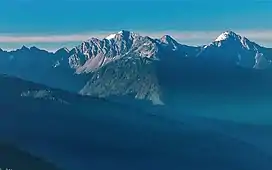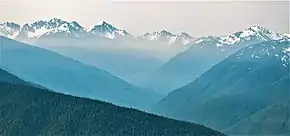Crystal Peak (Olympic Mountains)
Crystal Peak is a 6,896-foot-elevation (2,102-meter) mountain summit located within Olympic National Park in Jefferson County of Washington state. Crystal Peak is situated two miles north of Enchanted Valley, near the heads of Hayes River and Quinault River. Topographic relief is significant as the northeast aspect rises 3,300 feet (1,000 meters) above Hayes River in less than one mile. Precipitation runoff from the mountain drains north to the Elwha River via Hayes River and Godkin Creek. Neighbors include line parent Chimney Peak, 2.2 mi (3.5 km) to the south, and proximate parent West Peak, 2.0 mi (3.2 km) to the east.[2] The lower slopes of the mountain are surrounded by Western Red Cedar, Sitka Spruce, Western Hemlock, Alaskan Cedar, Mountain Hemlock, and Douglas-fir of the Quinault Rainforest.
| Crystal Peak | |
|---|---|
 North aspect of Crystal Peak centered, as viewed from Hurricane Ridge. (Chimney Peak to right) | |
| Highest point | |
| Elevation | 6,896 ft (2,102 m)[1] |
| Prominence | 896 ft (273 m)[1] |
| Parent peak | Chimney Peak (6,917 ft)[2] |
| Isolation | 1.98 mi (3.19 km)[2] |
| Coordinates | 47°43′13″N 123°23′29″W[3] |
| Geography | |
 Crystal Peak Location of Crystal Peak in Washington  Crystal Peak Crystal Peak (the United States) | |
| Location | Olympic National Park Jefferson County, Washington, US |
| Parent range | Olympic Mountains |
| Topo map | USGS Chimney Peak |
| Geology | |
| Age of rock | Eocene |
| Climbing | |
| First ascent | 1976 |
| Easiest route | class 2 scrambling[1] |
History
This landform was originally named "Mount McCullough" in 1890 by the 1889-90 Seattle Press Expedition, for J. B. McCullough, the editor of the St. Louis Globe-Democrat.[4] The mountain's present, official, descriptive name is attributable to quartz and silicates found in rocks on the peak's ridges.[5] The first ascent of the summit was made in 1976 by George Bauer, Ron Brown, Bill Foster, Bill Larson, Mike Lonac, Sue Ritter, Roy Teague, and Jim White.[1]
Climate

Based on the Köppen climate classification, Crystal Peak is located in the marine west coast climate zone of western North America.[6] Most weather fronts originate in the Pacific Ocean, and travel east toward the Olympic Mountains. As fronts approach, they are forced upward by the peaks of the Olympic Range, causing them to drop their moisture in the form of rain or snowfall (Orographic lift). As a result, the Olympics experience high precipitation, especially during the winter months. During winter months, weather is usually cloudy, but due to high pressure systems over the Pacific Ocean that intensify during summer months, there is often little or no cloud cover during the summer. The months June through August offer the most favorable weather for viewing or climbing this peak.[1]
Geology
The Olympic Mountains are composed of obducted clastic wedge material and oceanic crust, primarily Eocene sandstone, turbidite, and basaltic oceanic crust.[7] The mountains were sculpted during the Pleistocene era by erosion and glaciers advancing and retreating multiple times.
References
- Crystal Peak, climbersguideolympics.com
- "Crystal Peak - 6,896' WA". listsofjohn.com. Retrieved 2021-12-23.
- "Crystal Peak". Geographic Names Information System. United States Geological Survey, United States Department of the Interior. Retrieved 2021-12-23.
- Robert Wood, 1988, Across the Olympic Mountains: The Press Expedition, 1889-90, Mountaineers Books, ISBN 9781594858284.
- Parratt, Smitty (1984). Gods and Goblins: A Field Guide to Place Names of Olympic National Park (1st ed.).
- Peel, M. C.; Finlayson, B. L.; McMahon, T. A. (2007). "Updated world map of the Köppen−Geiger climate classification". Hydrol. Earth Syst. Sci. 11: 1633–1644. ISSN 1027-5606.
- Alt, D.D.; Hyndman, D.W. (1984). Roadside Geology of Washington. pp. 249–259. ISBN 0-87842-160-2.
External links
- "Olympic National Park". National Park Service.
- Weather forecast: Crystal Peak